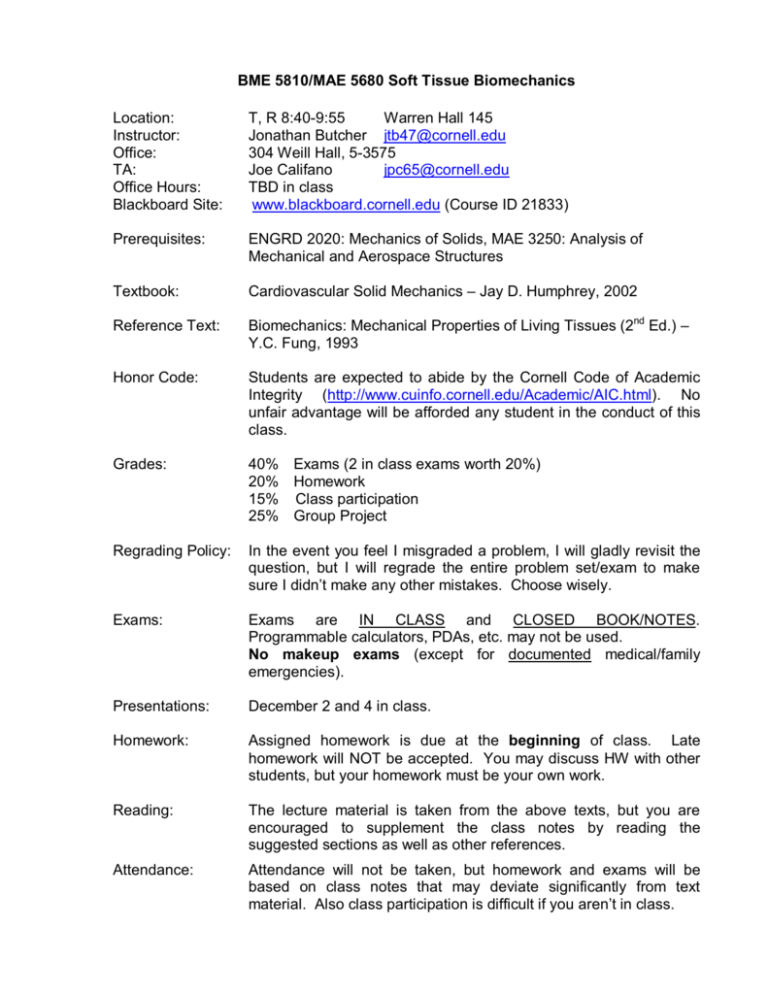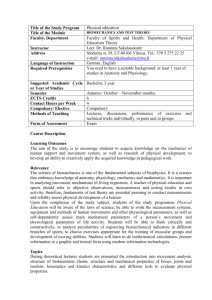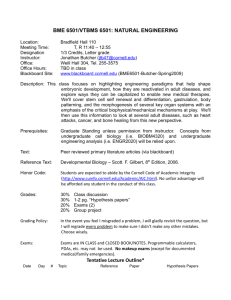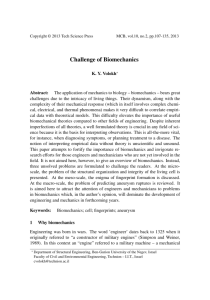BME 5810/MAE 5680 Soft Tissue Biomechanics
advertisement

BME 5810/MAE 5680 Soft Tissue Biomechanics Location: Instructor: Office: TA: Office Hours: Blackboard Site: T, R 8:40-9:55 Warren Hall 145 Jonathan Butcher jtb47@cornell.edu 304 Weill Hall, 5-3575 Joe Califano jpc65@cornell.edu TBD in class www.blackboard.cornell.edu (Course ID 21833) Prerequisites: ENGRD 2020: Mechanics of Solids, MAE 3250: Analysis of Mechanical and Aerospace Structures Textbook: Cardiovascular Solid Mechanics – Jay D. Humphrey, 2002 Reference Text: Biomechanics: Mechanical Properties of Living Tissues (2nd Ed.) – Y.C. Fung, 1993 Honor Code: Students are expected to abide by the Cornell Code of Academic Integrity (http://www.cuinfo.cornell.edu/Academic/AIC.html). No unfair advantage will be afforded any student in the conduct of this class. Grades: 40% Exams (2 in class exams worth 20%) 20% Homework 15% Class participation 25% Group Project Regrading Policy: In the event you feel I misgraded a problem, I will gladly revisit the question, but I will regrade the entire problem set/exam to make sure I didn’t make any other mistakes. Choose wisely. Exams: Exams are IN CLASS and CLOSED BOOK/NOTES. Programmable calculators, PDAs, etc. may not be used. No makeup exams (except for documented medical/family emergencies). Presentations: December 2 and 4 in class. Homework: Assigned homework is due at the beginning of class. Late homework will NOT be accepted. You may discuss HW with other students, but your homework must be your own work. Reading: The lecture material is taken from the above texts, but you are encouraged to supplement the class notes by reading the suggested sections as well as other references. Attendance: Attendance will not be taken, but homework and exams will be based on class notes that may deviate significantly from text material. Also class participation is difficult if you aren’t in class. BME 5810/MAE 5680 Course Outline Topics 1. Introduction 2. Review and Transition from Solid Mechanics 3. Tensor Analysis a. Indicial notation b. Properties and Manipulation of Vectors and Tensors c. Matrix Methods 4. Continuum Mechanics a. Analysis of Deformation/Strain Concepts b. Stress, Traction c. Balance Relations d. Linear Elasticity e. Constitutive Formulation 5. Biomechanical Property Measurement a. Experimental Devices b. Error analysis 6. Mechanotransduction a. Basic cell and matrix biology b. Stress sensor hypotheses 7. Finite Elasticity for Soft Tissue Biomechanics a. Uniaxial Extension b. Planar Biaxial Extension c. Tissue Anisotropy d. Inflation of a Tube e. Residual Stress of a Tube f. Composite Materials 8. *Viscoelasticity a. Linear models/Superposition b. Quasilinear viscoelasticity 9. *Muscle Activation 10. *Growth Biomechanics a. Volumetric growth b. Constituent based growth * Depending on time/interest Suggested Readings Fung Humphrey Ch.1 Ch.1 Ch.1 ----- -2.1-3 2.5 2.3 2.2 -2.8 7.8 -- 3.1 3.2 3.3 -3.4 -- --- 1.2 -- 7.5 7.9-10 --8.7 -- 4.2 4.2 Ch.10 4.2 4.2 -- 2.11 7.6 Ch. 9 --Ch. 10 --- 9.1 9.1





